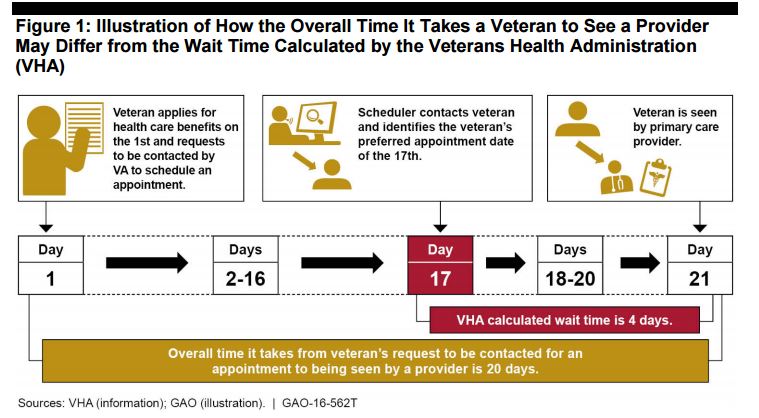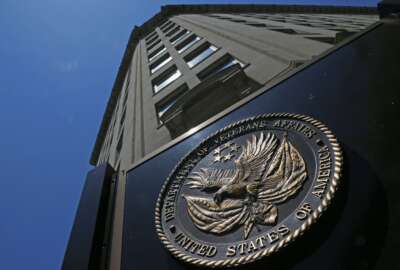
GAO’s veteran wait time reports differ vastly from VA’s
The Veterans Affairs Department says nearly 97 percent of veterans received an appointment at a VA medical center within 30 days. But the Government Accountability...
The Veterans Affairs Department says it’s made progress in slashing wait times for an appointment at a VA medical center. Nearly 97 percent of veterans received an appointment within 30 days, the VA said earlier this month.
But a new study from the Government Accountability Office paints a vastly different picture. GAO reviewed cases for 180 newly enrolled veterans at six Veterans Health Administration medical centers.
Of the 180 veterans, 120 received VA care, and the average wait times for an appointment ranged between 22 and 71 days, according to GAO’s recent study.
Roughly half of those veterans waited 30 days, while 12 waited at least 90 days for an appointment, GAO said.
At the time GAO completed its review, 60 veterans who asked for an appointment did not receive VA care, and 17 of those veterans were not contacted at all to schedule an appointment.
“The 96 percent and the data that’s been discussed today — we don’t see it,” said Larry Reinkemeyer, director of the Kansas City Office of Audits and Evaluations at the VA’s Office of Inspector General. “[In] every facility we go to, it’s not accurate.”
Because the data from VA’s nationwide reviews is inaccurate, Reinkemeyer said his office is asking local veterans service networks to gather their own data. Those reports will be more helpful, he said.
The reason for the discrepancies comes, in part, because VA and GAO use different criteria to calculate average wait times.
VHA calculates an appointment wait time starting at the veteran’s preferred date that he or she wants to be seen, not the date the veteran initially contacts the VA to set up an appointment.

“You will not find what you do not seek,” House Veterans Affairs Committee Chairman Jeff Miller (R-Fla.) said at a hearing on veterans’ access April 19. “The obvious result of VA reporting only a portion of a veteran’s actual wait time is artificially low results. I still understand how a culture could persist in presenting inaccurate data to this committee, or more importantly to the veterans of this country.”
David Shulkin, undersecretary for health at the VA, said the department would begin to measure wait times for newly enrolled veterans from the time the veteran indicates he or she would like an appointment. Ultimately, the department hopes it can cater to the veteran’s preference and gather feedback from them directly.
About 89 percent of veterans who have received VA care said they were satisfied or highly satisfied, Shulkin said.
But Rep. Raul Ruiz (D-Calif.) sees problems with that statistic as well.
“Of course they’re going to rate it good, because they’re already on the inside of the hospital,” he said. “How about asking those who don’t get access, to tell us what their access is going to look like?”
Scheduling problems
The department previously cited challenges with training its scheduling assistants, as well as the scheduling system itself, as reasons for the long wait times.
VA rescinded its scheduling policy in 2014 after cases of wait time manipulation came to light, said Debra Draper, director for health care at GAO. Since then, VA has issued memos with scheduling guidance to medical centers and field offices.
“It’s been a really piecemeal effect,” she said. “The field will tell us that it’s very confusing. They get memos and they don’t know what they’re supposed to be doing. You need a really good policy, which sets the stage for also really being able to do really good oversight. If you don’t have a really clear policy or steps you should be looking at in the scheduling process, it’s really hard to evaluate whether people are doing the right things or not.”
VA has 32,067 schedulers, Shulkin said. But turnover in that position is high: roughly 25 percent of employees in that position leave the job within a year. Scheduling assistants also lack a decent career path for advancement within the field, Draper said.
The department’s scheduling system, which dates back to the Vietnam War era, makes it easy for administration assistants to make mistakes, Draper added.
VA rolled out a new pilot scheduling program, the Veteran Appointment Request App and VistA Scheduling Enhancement, earlier this month. The department spent about $6.4 million for the VistA enhancement, Shulkin said.
The department is looking at a commercial solution for the Medical Appointment Scheduling System (MASS). Shulkin said the contract for a 10-month MASS pilot at three sites will cost roughly $152 million, with estimates for the entire project at roughly $600 million.
Clearing IG recommendations
GAO added VA health care to its biennial high risk list in 2015. More than 100 recommendations from the department’s inspector general haven’t been resolved.
Shulkin said he added a deputy undersecretary for organizational excellence when he arrived at the department nine months ago. Carolyn Clancy is responsible for specifically managing and addressing recommendations that come from the IG, though Shulkin said both he and VA Secretary Bob McDonald are ultimately held accountable.
Rep. Dan Benishek (R-Mich.) was baffled that one person alone was responsible for overseeing and implementing IG recommendations at the department.
“We’ve had so many inspector general reports where the VA secretary has agreed with the report and agreed to change it, but nothing’s changed in 20, 30 years,” Benishek said. “You realize that, right?”
Shulkin agreed.
GAO said it’s also worried. It’s meeting with VA leadership this month to help the department revise its action plan for getting off the GAO high risk list. VA submitted a draft action plan to GAO in January, but Draper said the department’s plan addressed one out of five criteria it needs to get off the list. She expects the VA will submit its final action plan in August.
“To date, we have seen at best, little progress by VA in addressing the issues,” Draper said. “We are very concerned about the lack of meaningful progress, and our concern is heightened further because the window of opportunity under the current administration is rapidly closing, if not already closed.”
Shulkin assured the Miller and other members: he’s as impatient as they are to resolve the VA’s problems, starting with discrepancies in the department’s health care data.
“We’re not afraid of this kind of criticism,” Shulkin said. “We welcome it. We want this type of transparency.”
Copyright © 2025 Federal News Network. All rights reserved. This website is not intended for users located within the European Economic Area.
Nicole Ogrysko is a reporter for Federal News Network focusing on the federal workforce and federal pay and benefits.
Follow @nogryskoWFED






